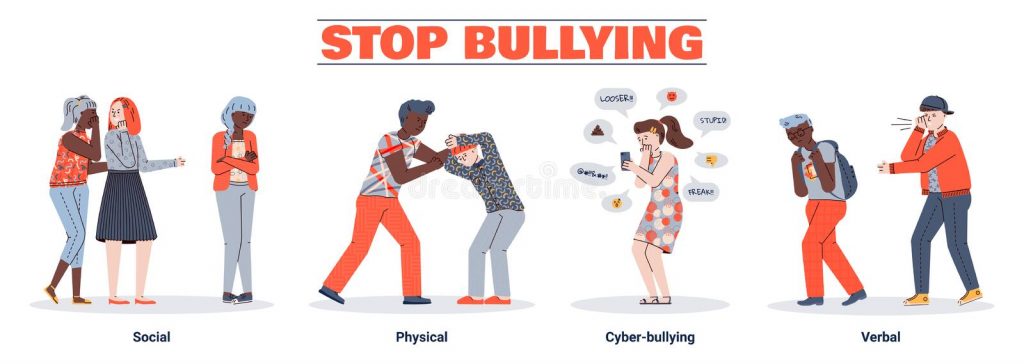Bullying at work will have a negative impact on performance at work and overall well-being. Discover the effects of bullying, and ways to put a stop to it.
Bullying is typically understood to be actions or verbal statements that might alienate or emotionally harm an employee. Bullying occasionally also includes harmful physical assault. Bullying often entails a behaviour pattern or numerous incidents meant to terrorize, insult, denigrate, and humiliate a specific individual or group of people. Asserting one’s dominance by force is another way to put it.
Here are the different types of bullying-
Bullying may take many various forms, some of which are easy to identify, while others may be insidious. It can affect both children and young adults. The various sorts of bullying discussed here are a few examples of how bullying may occur-

- Verbal bullying– Name-calling, obscenities, taunting, harassment, homosexual or racial statements, or abusive language are examples of verbal bullying. Although verbal abuse might begin innocuously, it has the potential to worsen to the point where the victim begins to feel the effects.
- Physical bullying– Physical harassment can take the form of pushing, shoving, tripping, striking, or destroying property. Bullying that is physically harming the victims in the long and short term.
- Cyberbullying– Cyber bullying is harm that is intentionally and repeatedly perpetrated through electronic devices like mobile phones, computers etc. – Cyber bullying Research Centre. Cyber bullying is any kind of bullying that takes place online and involves using digital tools like websites, texting, instant messaging, social media, and other online platforms.
Bullying includes –
- Unpleasant rumours or gossip.
- Harsh or unpleasant messages, emails, postings, photos, or videos.
- Intentionally exclude people online.
- They are utilizing someone else’s login or becoming someone else online.
- Social bullying– Social bullying is also known as covert bullying. It can occur behind the victim’s back and is frequently more challenging to identify. It is intended to degrade somebody’s status in society and make them feel humiliated.
It also includes –
- Hostile body language, threatening or dismissive stares.
- Imitating negatively.
- Causing harm to a person’s social standing or acceptability.
- Lying and spouting false information.
- Making offensive remarks to ridicule and disgrace.
- Provoking other people to isolate someone socially.
How do you identify bullying-
- Repeatedly criticizing someone’s looks, way of life, relatives, or religion
- Harsh, derogatory, or otherwise objectionable words used frequently or blatantly screaming
- Sharing offensive or humiliating images or videos through social media or on mail
- Unwelcome physical touch or ominous actions
- Consistently make someone the target of hoaxes or high jinx, or tease them in an unacceptable way
A Real-Life Workplace Bullying Example-
Microsoft pays $2 million. Why? Workplace bullying!
ADVERTISEMENT
Michael Mercieca ultimately witnessed the courts force Microsoft to pay restitution for harassment in the workplace after waiting seven years, which almost drove him to suicide. Microsoft was found guilty of “acting with malice and reckless disregard” in an organized campaign of office retribution against Mercieca by the Texas employment labour law case judge Tim Sulak.
What actions may workers take to stop workplace cyberbullying?
No one, absolutely no one in the workplace, has the right to bully you. If you ever feel you are a victim of cyber bullying at the workplace, please speak up. You can’t let it go on with the hope of it stopping one day. You should never forget that your supervisor might be utterly clueless about what is happening around you. You have to be very careful. The first thing would be posting safely on social media. The next is how to deal with it.
How do you respond to it?
- Pay attention to whatever is happening– Keep a note of any behaviour that is directed towards you. Snap pictures of any postings or remarks on social media, save emails and make notes on everything you suspect to be bullying.
- When confronting a bully directly, take precautions– Even though it might be natural to respond to a harsh or disrespectful remark, doing so is seldom the best move. Think carefully before deciding whether to reply or approach the individual who made the remarks. Avoid engaging in online disputes; any comments must be quiet and collected.
- Talking to a senior– Speaking out against bullying is challenging. But it’s crucial to not endure your suffering in quiet. Speak with your direct supervisor or the appropriate HR staff member. If you consider it to be too challenging, go to a teammate or coworker and call for support. Do not overlook bullying if you are mindful of it happening to anyone else.
- Look through your rights and privacy settings– Even if they don’t provide complete security, privacy measures are a fantastic starting point. Verify who follows you on social media and who has access to your postings. It’s important to remember to check your social network privacy settings often because they might change.
- Report it– When bullying occurs on a specific social media platform, it’s vital to use the reporting feature. This alerts them of the offensive comments. You can also report the bullying to a higher authority if it includes stalking, the act of violence or even death threats.
Takeaway
It’s critical to be aware of the indicators of work bullying. That is when you can exercise caution to safeguard yourself. Organizations may also take action to stop bullying by teaching staff how to react when they see someone being mistreated at work. It’s essential to raise your voice against anything that happens to you, just like how Michael Mercieca raised his voice and demanded justice. It did take time, but it’s never too late to mend.
ADVERTISEMENT
Considering the latest growth in cyber bullying incidents across the globe, here are a couple of tips from ExpressVPN to increase your online privacy.

ADVERTISEMENT








